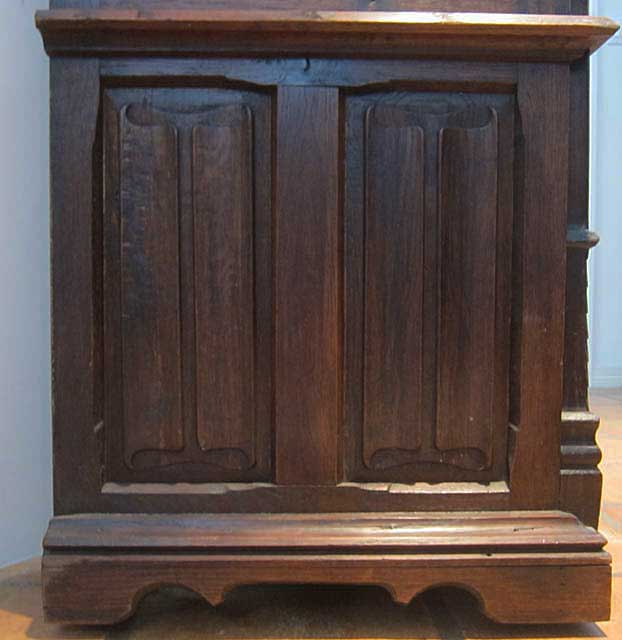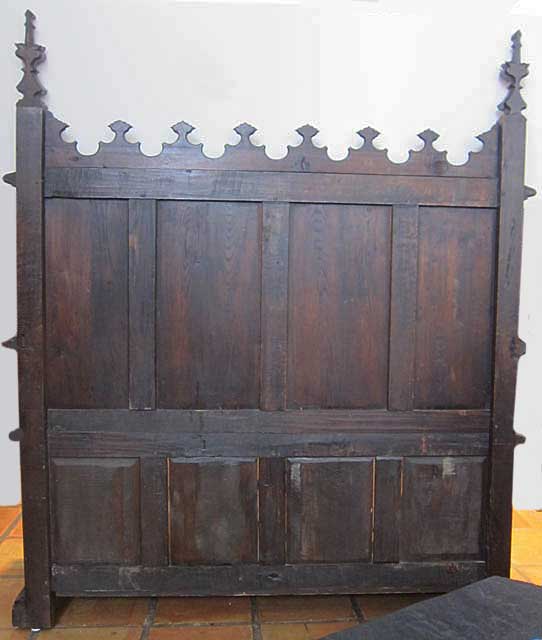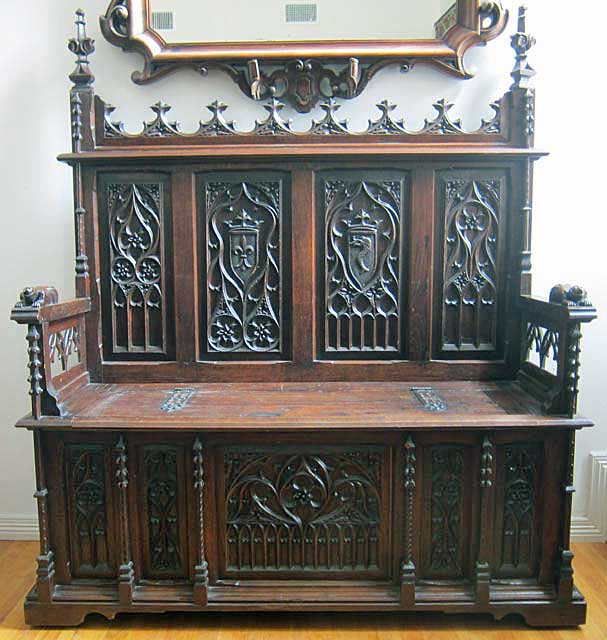
Over the years, we have found and sold a number of French antique benches in the Gothic style, but this is among the most remarkable, owing to its use of heraldic symbols, complex tracery, intricate carving, and enigmatic figures. It embodies what it means to be "Gothic" as understood down the ages to our time, reflected in both the overall design and masterful carving.
As a type of furniture, the bench or banc is one of the oldest forms and, like others, traces its lineage to the chest or coffre. By adding a backrest and arms, a chest became a bench while retaining its storage feature with the seat flipping up to reveal the space that was once the fundamental purpose for a chest in protecting valuables such as textiles.
In chateaus, the vestibules or entry areas were typically ringed with benches, heavily carved and often covered in pillows made of luxurious fabrics or draped with tapestries or carpets. Benches were also used in the bed chamber, frequently near the fire, in order to block drafts and increase warmth, as illustrated in the treatise by Eugène Viollet-le-Duc (cited, below). Benches were also used as seating at tables in the main hall of a chateau.
The skillfully carved fenestrage or tracery on this bench includes four panels above the seat and five below it. Each one of the four panels comprising the backrest is unique, a variation on the theme of tall, graceful, sweeping arches around and within which complex designs are found.
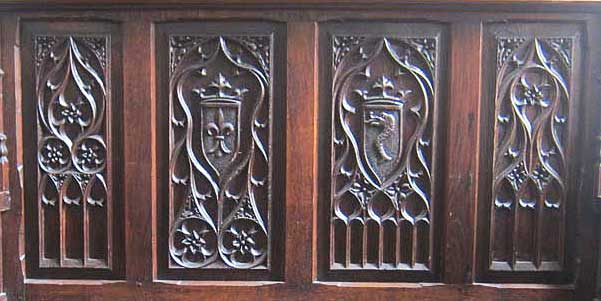
The first of the panel (viewed from left to right), has three lancet arches in the lower part. These tall thin arches, nipped in just below the top, were central to the vocabulary of Gothic architecture, especially below rose windows such as at Notre Dame de Paris. Furniture-makers used them as well, especially at the base of complex designs as in several instances on this bench. Above the lancet arches is a pair of quatrefoils or four-lobed figures framed by a circle and with a flower at the center. The upper half of the panel is comprised of concentric elliptical shapes ending in points at top and bottom. At the center is another quatrefoil with a flower inside but the upper and lower lobes end in points rather than rounded shapes. The two outer ellipses are filled with mouchettes, a basic shape, characterized by a gentle curve tapering to a point at both ends and with cusps dividing it in the middle, used to fill spaces of Gothic tracery. Acting like corbels to unite the upper corners of the panel to the curves of the ellipses are figures in the shape of leaves of holly, with their characteristic serrated edges, united by a berry in the center. In heraldry, such leaves are used to represent truth. This motif is seen in all four panels at the upper left and right corners.
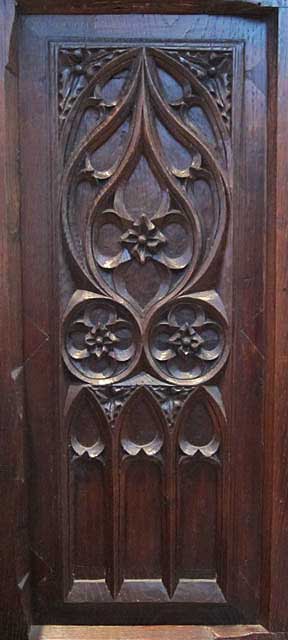
The second panel brings more heraldic symbolism into the picture, having at its center an escutcheon or shield. The focus of the heraldry is a fleur-de-lys, that most French of emblems signaling royalty. After the French revolution, when France ceased to have kings, the popularity of the emblem persisted and may have been used to indicate a connection to the nobility, preserved in wood and passed down through generations. We have a number of pieces in which the fleur-de-lys is prominent, coming in many shapes and forms, including Dressoir 5203, Throne Chair 5204, and Chest 5150. To learn more about the symbolism, visit the page about our 18th century (or earlier) Table 9210 that offers a festival of fleurs-de-lys.
Surrounding the shield and crown is a shape that gracefully curves, mimicking the basic shape of the shield and tapering to points at top and bottom. Below it and to the sides are mouchettes filling the space between this curved figure and the arch that forms the top curve of the panel. As in the preceding panel, there are holly leaves acting as corbels.
Below the shield is a pair of quatrefoils with flowers in the middle, similar to those on the previous panel, but this time they are enclosed in a soufflet or circular figure that is elongated and tapers to a point at one end. Filling the space of this elongated section are more holly leaves and on the outsides of it are more mouchettes.
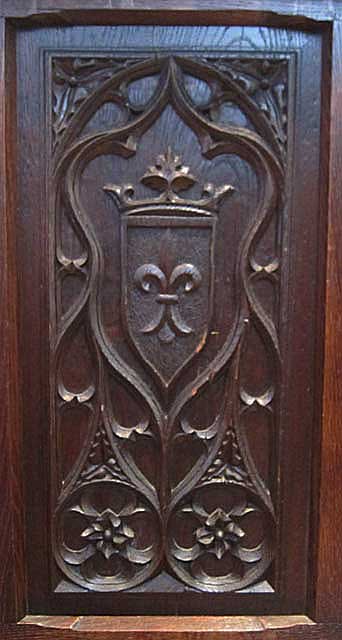
The third panel from the left involves one of our favorite heraldic symbols, the dolphin or dauphin that appears in various forms in furniture in our collection such as Cabinet 3094A, Throne Chair 4127, and a pair of Sgabelli 5222. Similar to the previous panel, the heraldic symbol of the dolphin appears on a shield that is surrounded by curving tracery and pairs of mouchettes. Below this, however, is a different motif consisting of three lancet arches whose lower portions have been divided in half, vertically. Flowers appear to be wedged into the space between the tops of the arches and the base of the tracery surrounding the shield.
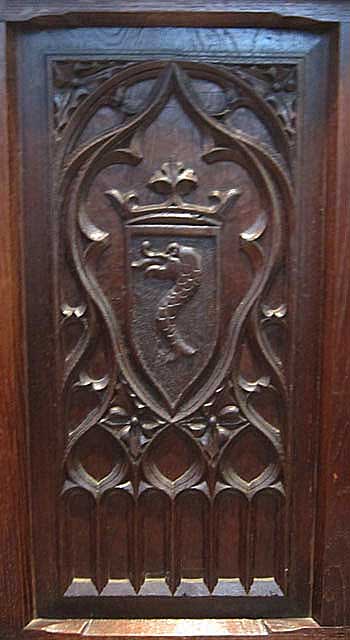
The dolphin is an allusion to dauphin, which in French is both the fish and the term used for the heir to the throne of France (typically, the king's eldest son). The reference dates back to Guy VIII, Count of Vienne (the principal city in the Dauphiné region of France), whose coat of arms included a dolphin and who had been nicknamed the "dauphin from Dauphiné." Guy's descendant sold his holdings to French King Philippe VI in the 14th century subject to the requirement that the heir to the throne assume the title "dauphin." Subsequent heirs to the throne incorporated the fish in their coats of arms with one of the best known being that of the future King Charles VIII of France (reigned 1483-1498, known as "the Affable"). Perhaps if he had chosen a more fierce symbol such as a lion he might have survived the fatal and reign-ending accident in which he hit his head while passing through a doorway at the Chateau of Amboise.
This dolphin however, differs from others we have seen. It is considered in heraldry to be engoulant because it is shown with a fish in its mouth. Our research has revealed no explanation for this but perhaps it was meant to symbolize a certain triumphalism, with the dolphin viewed as "the king of fish" gobbling up its pesky rivals.
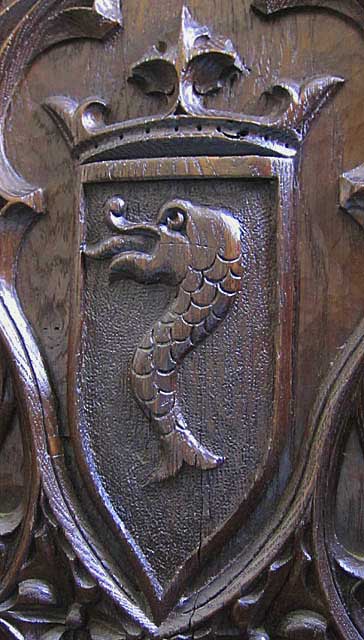
The fourth and last panel on the upper part of the bench is similar in design but not identical to the first. Within an overall shape of a pointed arch are various elements of tracery. Central to the design is another quatrefoil, as in the first panel, but instead of two lobes tapering to points, in this panel it is only the bottom lobe that is pointed. It extends downward, within a soufflet, to intersect the top of the middle of three lancet arches almost identical to the lower part of the first panel. Filling in the balance of the area above them, between the quatrefoil and the outer arch, are pairs of mouchettes.
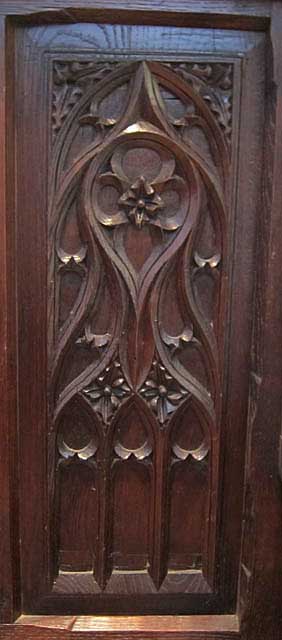
Crowning the back, above the four tracery panels, is a railing in a half-moon design sitting on a wide moulding. At each end of the railing are smaller finials, used as pilasters, to show the termination of the thin columns that ascend from the top of the armrests. In between is the railing comprised semicircles separated by cusps to demarcate three lobes.
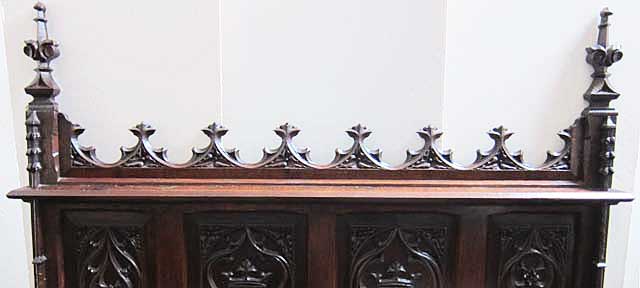
Dividing each of these semi-circles are flame-like figures (possibly stylized fleur-de-lys). They remind us that the two side lobes of each semi-circle can also be viewed as arches culminating in the flame-like figures that characterized flamboyant Gothic design (for more about this see Flamboyant Gothic on our Stylistic Origins page. These figures were also incorporated in the crown above the shield in the first panel, above.
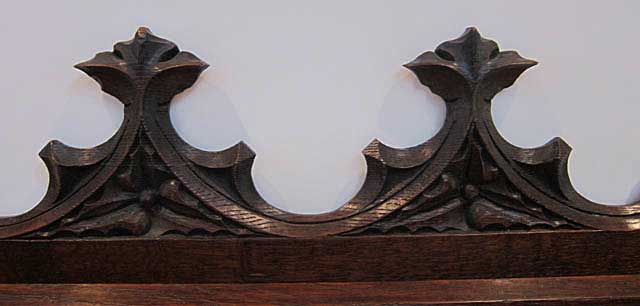
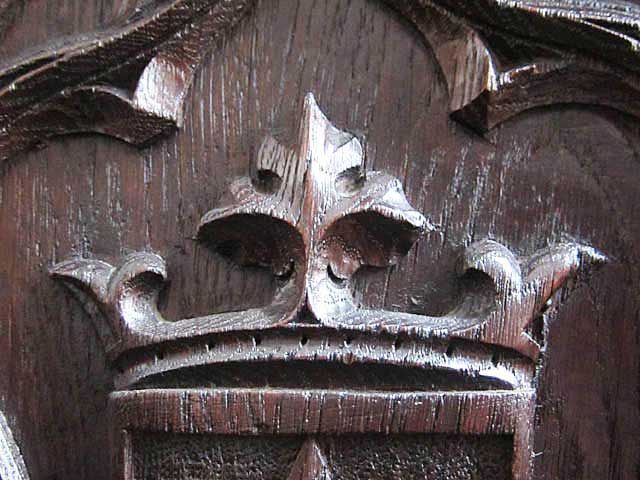
At each end of the railing is a finial sitting atop a square column. In design, they are fairly simple. Above a triangular-shaped base is a central spire with a crocket (stylized, furled acanthus leaf) on either side. The top of the spire has a slightly broader top, perhaps designed to evoke a flame or fleur-de-lys, but remaining somewhat indistinct.
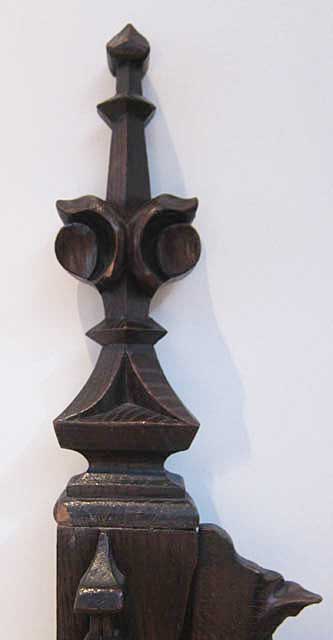
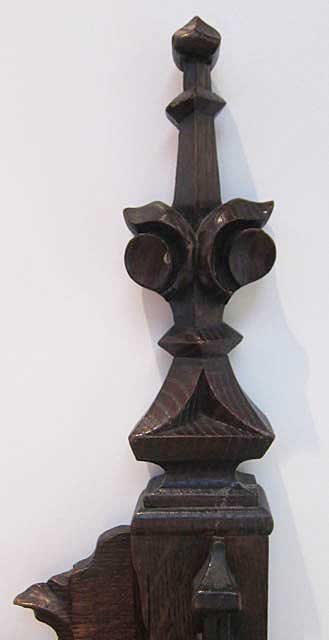
As mentioned above, the finials can be removed in order to avoid damaging them when moving the bench. A dowel sticks up from the top of the bench and the finial is mounted over it.
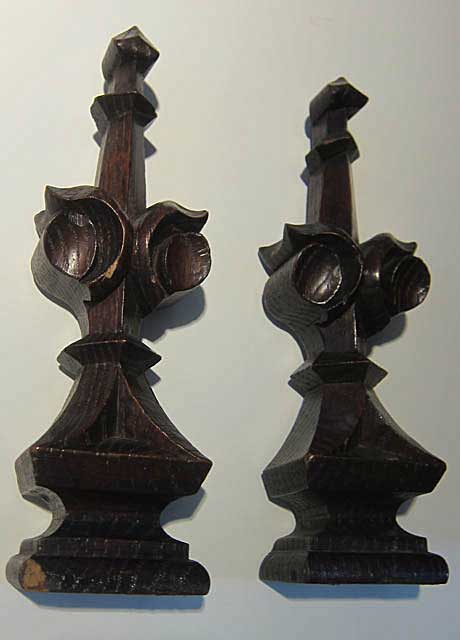
The design for the base of the bench is unusually elaborate for an area that typically attracts less attention on the part of furniture designers and is often filled with repetitious panels of stock figures such as plis de serviette. A central panel is approximately twice the width of the panels found on the upper part of the bench. On either side of it are two sets of narrow panels, each about one-half the width of the panels on the upper part. On both sides of each panel are tall, slim pilasters topped by spires with crocketing on the sides. The column of each finial bears a different geometric pattern reminiscent of the columns in Gothic cathedrals.
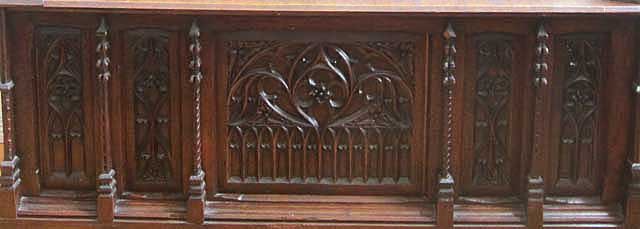
The wide, central panel is a lovely example of complex tracery incorporated within a broad rounded arch. The design can be divided into upper and lower halves. The upper half is laid out in the rounded part of the arch. In the middle is an elliptical shape, pointed at both ends, in which there is a quatrefoil whose bottom lobe tapers to a point, similar to the one in the center of the fourth panel of the upper part of the bench. Filling the space above the quatrefoil and inside the ellipse is a mouchette on either side. Echoing the rounded arch that frames the upper portion of this panel, on either side of the quatrefoil are smaller rounded arches filled with mouchettes and a figure of three holly leaves with a berry in the center. Filling out the space above the smaller side arches and the large central arch are trefoils whose lobes taper to a point. As in the four panels on the back of the bench, the holly leaf figure fills the space between the corner of the panel and the central arch. The lower half of this central panel is made up of a row of twelve lancet arches. Balanced, rich in detail, the panel attracts the viewer's eye to linger and enjoy.
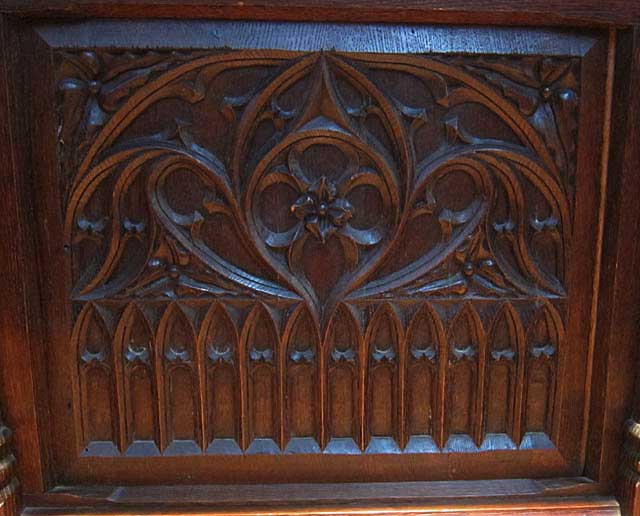
The slim panels comprising the outermost sections of the base are identical. Evoking elements of the fourth (last panel on the right) of the upper part of the bench, the main element is a pointed arch in which a quatrefoil is found. Its bottom lobe is not rounded but rather tapers downward to a point between the two lancet arches comprising the lower part of the panel. Filling the balance of the arch above the quatrefoil are two mouchettes.
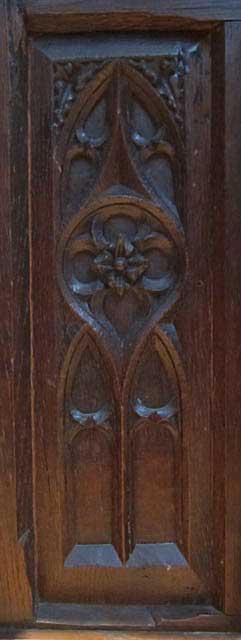
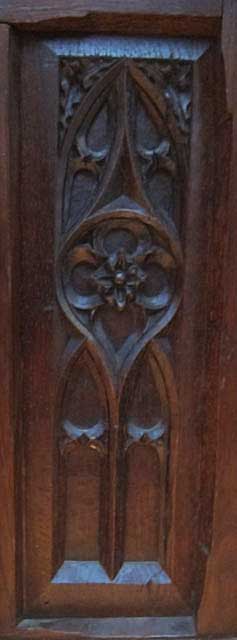
The panels on either side of the central panel are also identical. They evoke the first panel on the left of the upper part of the bench, with its focus a quatrefoil whose upper and lower ends are elongated and taper to points. Instead of a pointed arch, the main arch of the upper part of the panel is rounded. Filling the space within this arch and connecting to the quatrefoil are mouchettes. The lower part of these panels is comprised of a pointed arch opening out from the bottom lobe of the quatrefoil where mouchettes are found on either side. Within the lower arch are mouchettes on the sides and a central figure comprised of three holly leaves joined in the center with a berry.
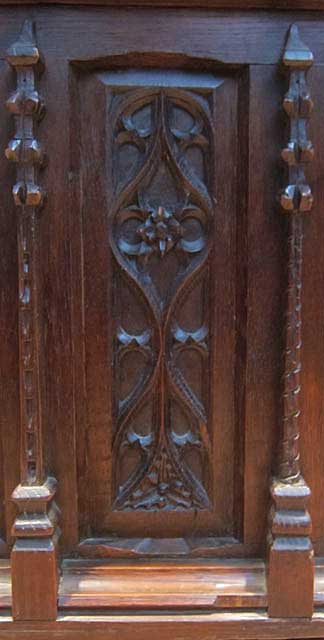
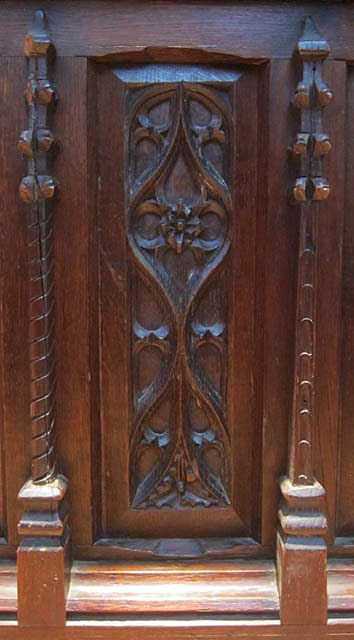
Another unusual element of this bench is the elaborate and intricately carved armrests above two linen-fold or pli de serviette panels.
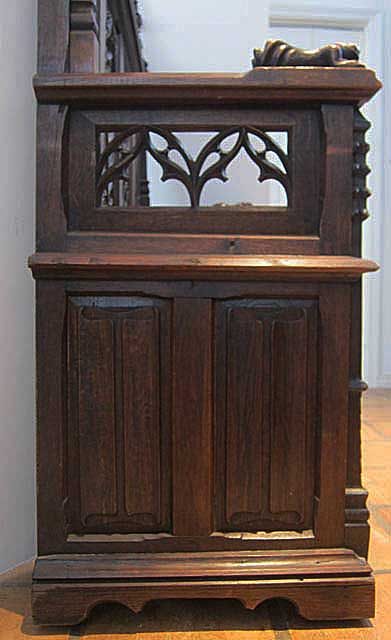
Above the panels are two open tracery figures evoking the half-moon or semi-circle design of the railing at the top of the bench, only inverted. Each pointed arch contains within it an ogee or S-shaped arch whose sides are curved. Uniting the two arches are mouchettes. The interior of the ogee arch has two cusps, lending it the feeling of an open trefoil design.
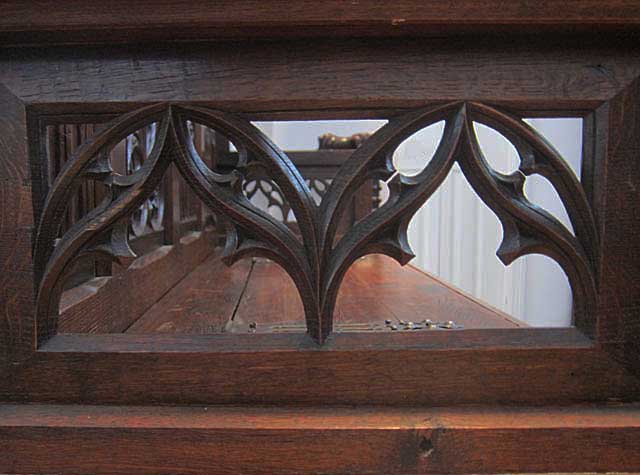
Atop each armrest are the only human figures on this bench.
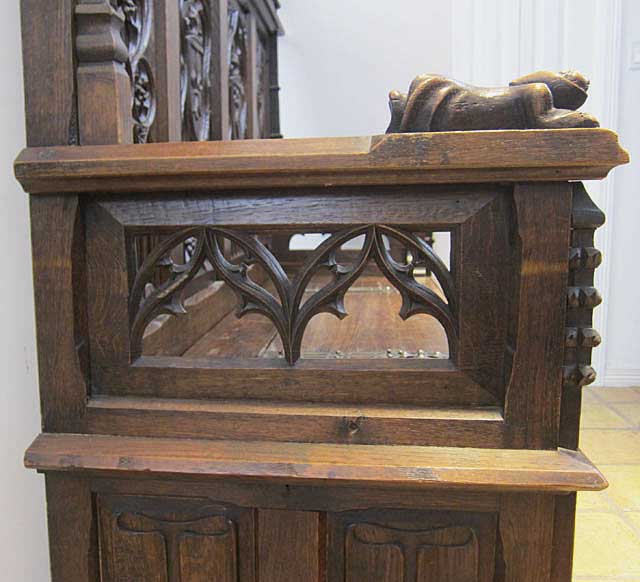
While it is not uncommon to have carvings of hooded figures on benches (see, for example, 5177, 4180, and 4173, they are typically heads and not entire bodies, as in this case.
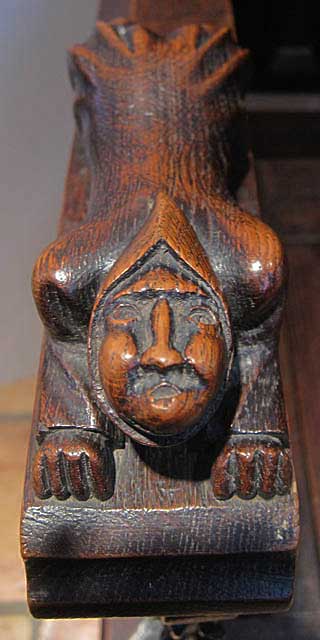
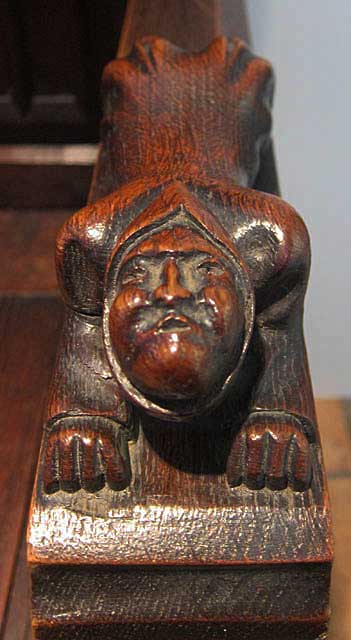
Each monk bows down, as he would before the altar in a church. His back is arched and his knees are tucked up under his habit.
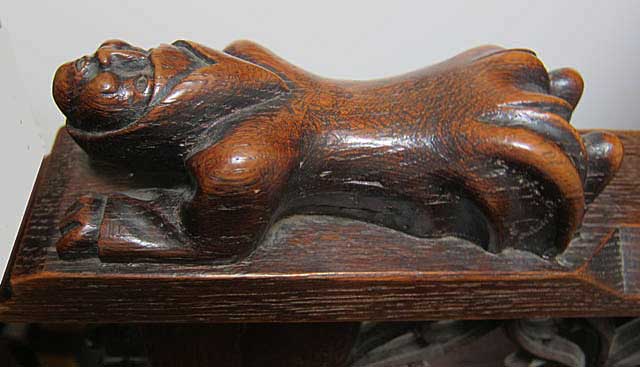
Viewed from above, his cowl is visible, having slid back from his upturned head. The folds of his habit flow outward toward his feet.
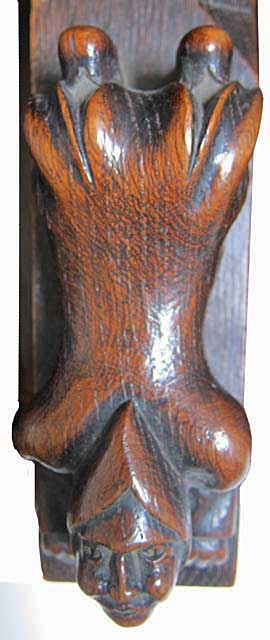
Behind and extending out from the habit are bare feet. Appearing well-worn, perhaps they reflect a barefoot pilgrimage to Santiago de Compostela?
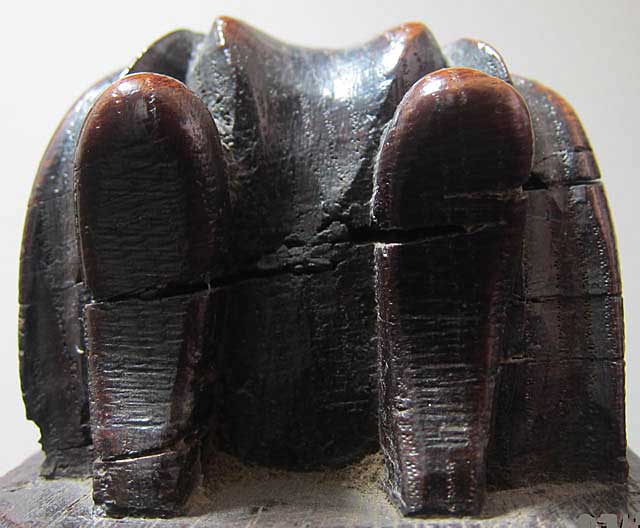
Leaning on his elbows, the monk's intricately carved fingers extend out before him. His face is turned upwards, towards heaven, bearing an expression of seriousness and piety.
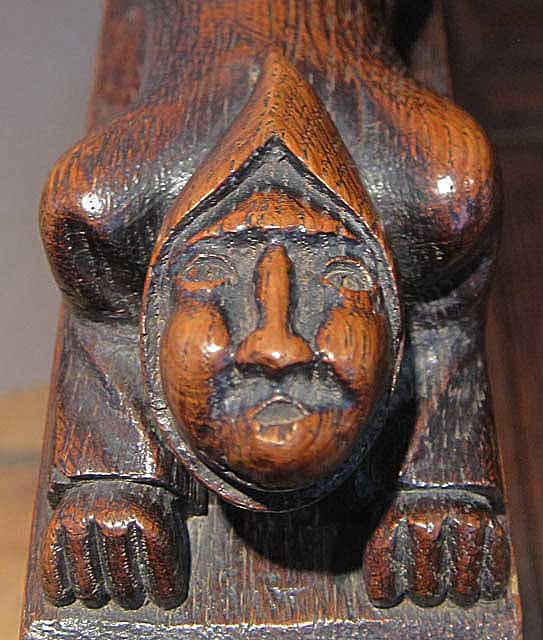
How comforting to sit on the bench and run one's hands over the crouching figures, perhaps drawing inspiration from their presence in exquisitely carved oak. Such penitent creatures have a long history in French furniture, especially on the armrests of choir stalls made for cathedrals in the 15th and 16th centuries.
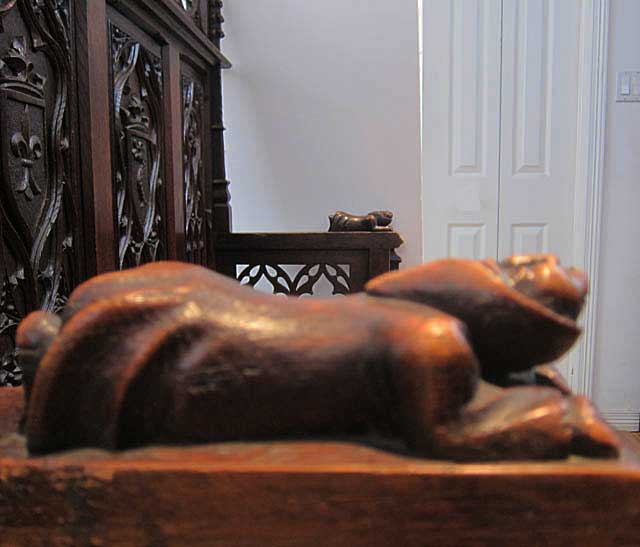
Below each monk, viewed from the front of the bench, is another pilaster in the form of a Gothic spire with elaborate crocketing.
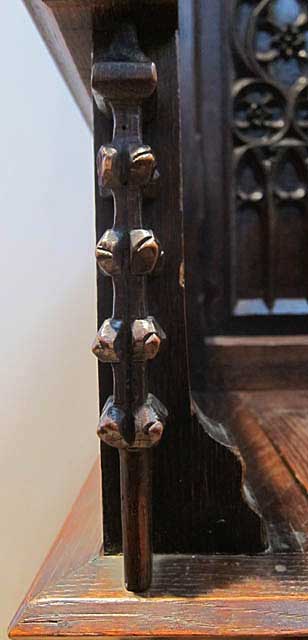
The door to the bench's storage area runs almost the full width of the seat, ornamented with two elaborate metal hinge straps.
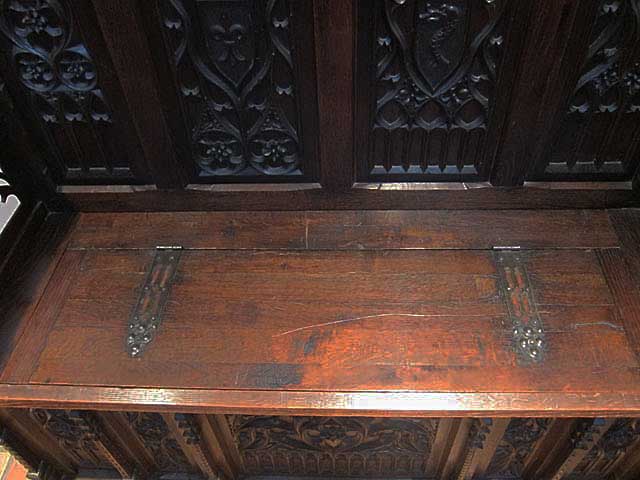
The interior space is ample, including for holding pillows, when not in use, such as these based on The Lady and the Unicorn tapestries from the Cluny Museum in Paris.
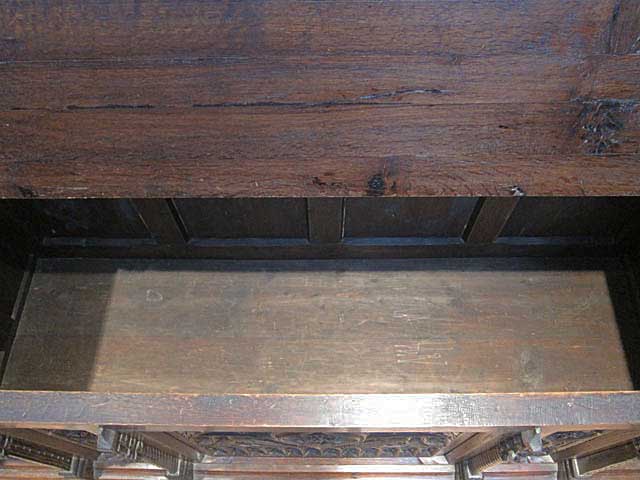
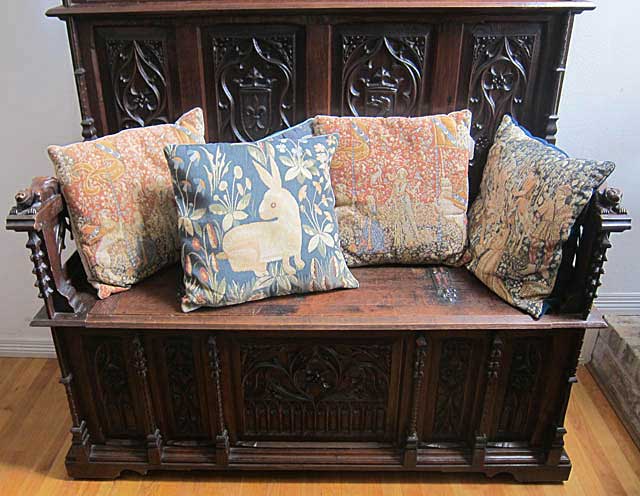
Reference
Boccador, Jacqueline, Le Mobilier Français du Moyen Age à la Renaissance (Editions d'Art Monelle Hayot, Saint-Just-en-Chaussée, 1988); Boussel, Patrice, Les Styles du Moyen Age à Louis XIV (Baschet et Cie, Paris, 1979); Piat, Florence, Les stalles de l’ancien Duché de Bretagne, (L'Université Européene de Bretagne, Rennes, 2012); Thirion, Jacques, Le Mobilier du Moyen Age et de la Renaissance en France (Editions Faton, Dijon, 1998); Viollet-le-Duc, Eugène, Le Mobilier Médiéval (Georges Bernage, editor) (Editions Heimdal, 2003).
Uses
This bench is larger than most we have seen, both in height (including the finials that are removable to avoid damage in moving) and width (to accommodate the panels of complex Gothic tracery). As the following photo shows, it looks wonderful below an 18th century Cuban mahogany mirror in Fontainebleau style. Particularly striking is the rich, dark patina of the wood set off against the bright white walls bathed in sunshine.
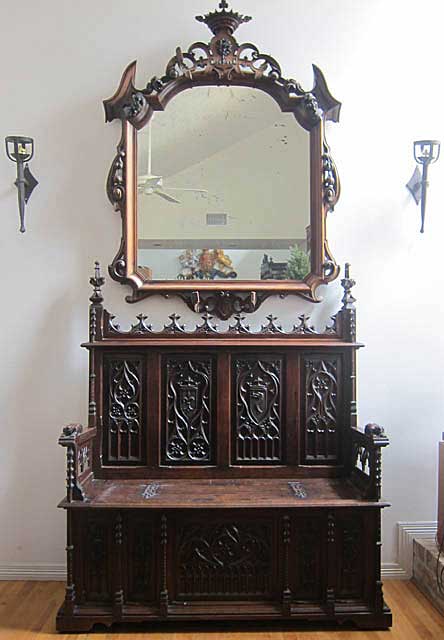
Additional Photos
